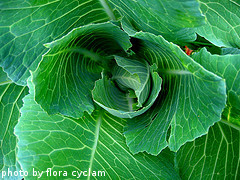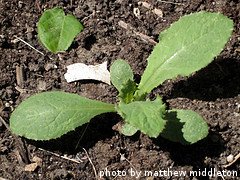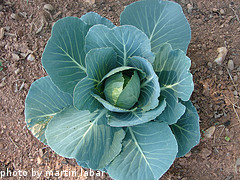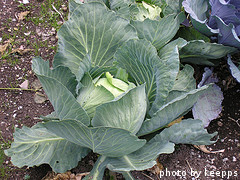Fertilizing and Watering Cabbage
Fertilizing and watering cabbage plants is important because they are such heavy feeders. A lack of nutrients will stunt their growth, leading to undersized and poorly developed heads. They use water to absorb the nutrients from the soil. Additionally, cabbage has a high water content, so without enough water, the heads will dry out, crack and become bitter.
Watering Cabbage
Cabbage needs about 1 1/2 inches of rain per week for best results. If you don't get this much rain in your area in a week, you'll need to water your cabbage plants yourself. You can use a soaker hose, jugs, or a regular hose to get the job done.

If no rain falls in your area, give your cabbage plants one good, deep soak per week. This method is much better than several shallow soaks as cabbage roots run deep. When watering cabbage plants, keep the water pressure low to avoid eroding away the soil around the plants. It's a good idea to focus your efforts at the base of the plants. Watering the tops of the plants can encourage pests and diseases. It's also a good idea to water in the early morning hours. That way, any excess water that may have gotten on the leaves will be evaporated by the afternoon sun.

Cabbages are thirsty plants and it's important that they get enough water. However, like other plants, they don't do well if they sit in soggy soil for too long. The best way to check to see if your cabbage plants need water is to use your fingers and dig down into the soil a few inches next to your plants. Grab a handful of dirt and squeeze is firmly in your palm. You want the soil to be moist enough that it holds together for a few seconds before crumbling. If the soil stays together and you can feel water in it, it's probably too wet. Let it dry out for a few days and check again. If the soil doesn't stick together at all when squeezed and just crumbles, it's likely too dry and you should water your plants.
Fertilizing Cabbage
As mentioned before, cabbage plants are heavy feeders and will do well with a couple of doses of fertilizer throughout the growing season.
You can add fertilizer to the soil just before transplanting cabbage seedlings. Choose a well-balanced granular fertilizer and sprinkle it over the area where you intend to grow cabbage. Till the fertilizer into the soil. 10-10-10 or 12-12-12 fertilizer works well. These three numbers are located on the side of the fertilizer package and tell you how much nitrogen, potassium and phosphate are contained in that particular fertilizer. Most granular fertilizers are applied at a rate of 1 1/2 pounds per 100 square feet of garden space. Check the label on the fertilizer package and follow the manufacturer's directions for the rate of application.

Once the seedlings are about 6 inches tall, you can fertilize them again with a well-balanced water soluble fertilizer. Just mix it with water according to the manufacturer's instructions and spray around and on your cabbage plants. At this stage, it's better to avoid granular fertilizers as they will burn the cabbage plants if they come in direct contact with them.
When the cabbage plants begin to form heads, a second dose of water-soluble fertilizer can be added. This will give the plants the energy boost they need to produce large, nicely formed heads. This second fertilizer dose probably won't be necessary if you are growing Chinese or other fast-growing, loose leaf cabbage varieties. These varieties typically mature so fast that they don't need an additional dose of nutrients.
In our own garden, we add a balanced granular fertilizer to the soil about a week before we want to plant our cabbage. We scatter it at a rate of 1 pint per 100 square feet of garden space. We also scatter in pulverized lime as our soil is somewhat clay-like and slightly acidic. After we scatter in the fertilizer and lime, we till the soil again to work the additives into the soil and then we water them in. After that, we wait until the soil has dried back out before we till one last time and then build our raised rows. From then on, we switch to a balanced water-soluble fertilizer product and apply it a couple of times throughout the growing season - once when the cabbage seedlings are about 6 inches tall and again when the heads start to form.
Now that you know about fertilizing and watering cabbage plants, it's time to learn about harvesting cabbage.

Click here to learn about harvesting cabbage
Click here for some of our favorite cabbage recipes
Click here to move from our Fertilizing and Watering Cabbage page to our Growing Cabbage main page
Click here to go to our Home page